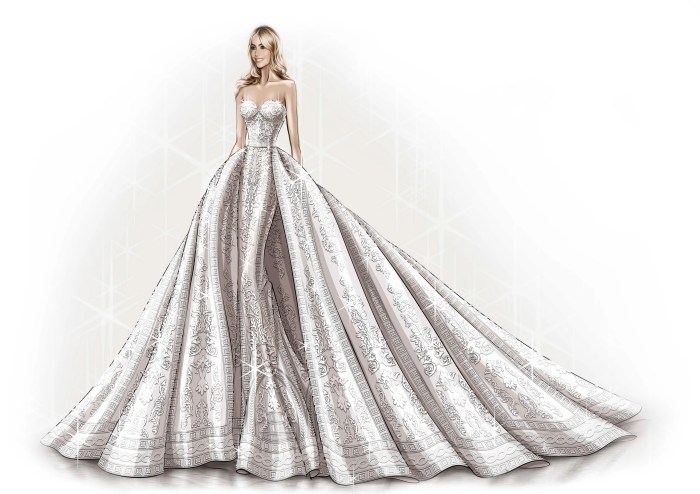Understanding the Online Wedding Dress Design Market
Wedding dress designer online – The online wedding dress market is a dynamic and rapidly evolving landscape, influenced by technological advancements and shifting consumer preferences. This section explores current trends, key demographics, and the advantages and disadvantages of online versus in-store purchases, alongside a review of different business models employed by online designers.
Current Trends in Online Wedding Dress Design
Current trends showcase a move towards personalization, sustainability, and accessibility. Many designers offer customizable options, allowing brides to modify existing designs or create entirely unique gowns. Sustainable fabrics and ethical production practices are increasingly important to environmentally conscious brides. Additionally, the rise of virtual try-on technology and detailed online sizing guides enhances the online shopping experience, addressing a key concern for online purchases.
Key Demographics of Online Wedding Dress Customers
The online wedding dress market attracts a diverse range of customers, but some key demographics stand out. Millennials and Gen Z brides are particularly active online shoppers, valuing convenience and the wider selection available digitally. Budget-conscious brides also find online platforms appealing, often offering a wider price range than brick-and-mortar stores. Geographically dispersed brides find online shopping particularly convenient, eliminating the need to travel to physical boutiques.
Advantages and Disadvantages of Buying a Wedding Dress Online vs. In-Store
Buying a wedding dress online offers unparalleled convenience and selection, often at lower prices. However, the inability to physically try on the dress before purchase and potential shipping delays are significant drawbacks. In-store purchases offer the tactile experience and expert advice but often come with higher prices and limited selection.
- Online Advantages: Wider selection, lower prices, convenience, accessibility.
- Online Disadvantages: Inability to try on, potential sizing issues, shipping delays, lack of personal styling advice.
- In-Store Advantages: Physical try-on, expert advice, immediate gratification, personalized service.
- In-Store Disadvantages: Limited selection, higher prices, potential travel inconvenience.
Different Business Models Used by Online Wedding Dress Designers
Online wedding dress businesses utilize various models, including direct-to-consumer brands, marketplace platforms (like Etsy), and designers who offer both online and offline sales channels. Some focus on ready-to-wear designs, while others specialize in custom-made gowns, leveraging online consultations and virtual design tools.
The burgeoning online market for wedding dress designers offers diverse styles and customization options. A significant influence on contemporary bridal design stems from iconic cinematic representations, such as the transformative gown featured in the wedding dress cinderella movie. This enduring image continues to inspire designers, impacting current trends in silhouette, fabric choice, and embellishment, further enriching the options available to modern brides through online platforms.
The Design Process for Online Wedding Dress Designers
Designing wedding dresses for an online platform requires a unique approach, integrating technology and client interaction to create a seamless and personalized experience. This section details the design process, technological tools, design styles, and client interaction strategies.
Steps Involved in Designing a Wedding Dress for an Online Platform, Wedding dress designer online
The process typically begins with initial client consultations (often virtual), followed by design development using 3D modeling software. This allows for virtual try-ons and adjustments before actual production. Once the design is finalized, the dress is produced, quality-checked, and shipped to the client. Throughout the process, consistent communication and feedback mechanisms are crucial.
Use of Technology in the Design Process
Technology plays a vital role, from 3D modeling and virtual try-ons to online design tools and digital fabric swatches. 3D modeling allows designers to visualize the gown in three dimensions, enabling clients to see the design from various angles and make adjustments before production begins. Virtual try-on technology uses augmented reality (AR) or AI-powered body scanning to allow clients to virtually “try on” the dress, minimizing sizing concerns.
Different Design Styles and Their Suitability for Online Presentation
Different design styles have varying levels of suitability for online presentation. Simple, clean designs with clear lines and textures photograph well and translate effectively online. Intricate details might require high-quality photography and videography to be fully appreciated. A well-designed website with high-resolution images and detailed descriptions is crucial for showcasing the designs effectively.
Step-by-Step Guide on Designer-Client Interaction
Effective communication is paramount. The process typically involves: initial consultation (virtual or in-person), design development and revisions, fabric selection, fitting (virtual or in-person, depending on location and design complexity), production, delivery, and after-sales support.
Marketing and Sales Strategies for Online Wedding Dress Businesses
Effective marketing and sales strategies are crucial for success in the competitive online wedding dress market. This section Artikels social media campaigns, effective showcasing techniques, suitable advertising platforms, and pricing strategies.
Social Media Marketing Campaign
A successful campaign targets engaged brides-to-be using platforms like Instagram, Pinterest, and Facebook. Visually appealing content, including high-quality images and videos of the dresses, is key. Targeted advertising allows designers to reach specific demographics and interests. Influencer marketing, collaborating with wedding bloggers and influencers, can significantly expand reach and credibility.
Showcasing Wedding Dress Designs Online
High-quality photography and videography are essential. Detailed descriptions should highlight fabric, construction, and design details. Customer reviews and testimonials build trust and social proof. Interactive elements, such as 360-degree views and virtual try-ons, enhance the online experience.
Online Advertising Platforms
Platforms like Google Ads, Instagram Ads, and Pinterest Ads allow for targeted advertising campaigns. Collaborating with wedding planning websites and blogs can also drive traffic to the online store.
Pricing Strategies for Online Wedding Dress Sales
Pricing strategies vary depending on the brand and target market. Value-based pricing, highlighting the quality and craftsmanship of the dresses, is effective. Competitive pricing, aligning with market rates, is crucial. Promotional offers and discounts can attract customers, but must be carefully managed to maintain profitability.
Customer Experience and Service

Source: josabimariees.com
Providing an exceptional customer experience is vital for success in the online wedding dress market. This section details the ideal customer journey, the importance of reviews, effective customer service strategies, and handling returns and exchanges.
Ideal Customer Journey for Purchasing a Wedding Dress Online
The ideal journey begins with easy website navigation and clear product information. A seamless checkout process, secure payment options, and timely order updates are crucial. Proactive communication from the designer throughout the process builds trust and manages expectations. Post-purchase follow-up and support further enhance the experience.
Importance of Customer Reviews and Testimonials
Positive reviews and testimonials build trust and credibility. They showcase the quality of the dresses and the level of customer service. Encouraging customers to leave reviews and actively responding to feedback demonstrates a commitment to customer satisfaction.
Effective Customer Service Strategies for Online Wedding Dress Sales
Prompt and helpful responses to inquiries, proactive communication about order status, and readily available customer support channels are crucial. Personalized communication and a willingness to address concerns demonstrate a commitment to customer satisfaction.
Handling Returns and Exchanges for Online Wedding Dress Purchases
A clear and straightforward return policy is essential. This policy should Artikel the conditions for returns and exchanges, the timeframe for returns, and the process for refunds or exchanges. Transparent communication and a hassle-free return process minimize customer frustration.
| Step | Action | Timeframe | Responsibility |
|---|---|---|---|
| 1 | Customer initiates return/exchange request | Within [Number] days of delivery | Customer |
| 2 | Designer confirms request and provides return shipping instructions | Within [Number] business days | Designer |
| 3 | Customer ships the dress | Within [Number] days of receiving instructions | Customer |
| 4 | Designer receives and inspects the dress | Within [Number] business days | Designer |
| 5 | Designer processes refund or exchange | Within [Number] business days of inspection | Designer |
Legal and Ethical Considerations: Wedding Dress Designer Online
Operating an online wedding dress business requires careful consideration of legal and ethical responsibilities. This section addresses key legal aspects, ethical considerations regarding sizing, body image, and pricing, and the importance of transparency.
Key Legal Considerations for an Online Wedding Dress Business
Compliance with consumer protection laws, data privacy regulations (like GDPR), and intellectual property rights (copyright protection for designs) are paramount. Clear terms and conditions, a privacy policy, and secure payment processing are essential.
Ethical Considerations Related to Sizing, Body Image, and Fair Pricing
Offering a diverse range of sizes and promoting body positivity is ethically crucial. Accurate sizing charts and clear descriptions are essential to avoid misleading customers. Fair pricing practices, transparent about production costs and markups, build trust and maintain ethical standards.
Importance of Transparency in Online Business Practices
Transparency in pricing, materials, production processes, and return policies fosters trust and builds a strong reputation. Openly communicating about potential delays or challenges demonstrates integrity and manages customer expectations.
Best Practices for Ethical Marketing and Advertising
Avoid misleading or exaggerated claims. Use authentic imagery and avoid digitally altering images to unrealistic standards. Respect intellectual property rights and obtain necessary permissions for using images or designs.
Future Trends in Online Wedding Dress Design

Source: greenweddingshoes.com
The online wedding dress market is poised for continued growth, driven by technological advancements and evolving consumer preferences. This section explores future trends, the impact of emerging technologies, potential challenges, and the integration of sustainability.
Future Trends in Online Wedding Dress Design and Technology
Personalized design tools using AI, virtual reality (VR) and augmented reality (AR) for virtual try-ons, and sustainable and ethically sourced materials will likely shape the future. Increased use of 3D printing for customized designs and on-demand production is also anticipated.
Potential Impact of Emerging Technologies
AI-powered design tools can help create personalized designs based on customer preferences. VR and AR technologies can enhance the online shopping experience, allowing customers to virtually try on dresses and visualize the fit. 3D printing can enable on-demand production, reducing waste and lead times.
Potential Challenges and Opportunities

Source: vogue.com
Maintaining data security and privacy, addressing concerns about sizing and fit in online sales, and managing the complexities of international shipping are key challenges. Opportunities lie in expanding into new markets, leveraging emerging technologies, and focusing on sustainability and ethical production.
Integrating Sustainability and Ethical Sourcing
Using sustainable fabrics like organic cotton or recycled materials, partnering with ethical manufacturers, and minimizing waste throughout the production process are crucial for environmental responsibility. Transparency about sourcing and production practices builds consumer trust and aligns with growing consumer demand for ethical and sustainable products. Examples include brands showcasing their use of recycled fabrics or highlighting fair labor practices in their supply chain.
Quick FAQs
How do I choose a reputable online wedding dress designer?
Look for designers with established online reviews, transparent policies, secure payment gateways, and clear communication channels. Check for professional website design and high-quality product photography.
What are the common sizing challenges with online wedding dress purchases?
Accurate measurements are crucial. Many designers offer detailed sizing guides and virtual consultations to help determine the correct fit. Consider ordering samples or utilizing virtual try-on technology if available.
What if my online-ordered dress doesn’t fit?
Reputable designers offer clear return and exchange policies. Carefully review these policies before ordering. Contact customer service immediately if there are any issues with the fit or quality of the dress.
How can I protect my intellectual property when designing wedding dresses online?
Register your designs with the appropriate copyright office and clearly mark your designs as copyrighted. Use watermarks on online images and consider non-disclosure agreements with clients.
